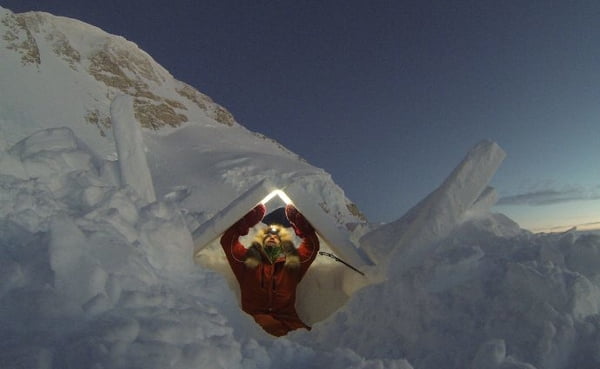
Daily Mountain
48 years, Australia
Lonnie Dupre to Attempt First Solo Winter Ascent of Begguya (Mt. Hunter), Alaska
Lonnie Dupre, an arctic explorer from Minnesota, is heading North. At the beginning of January he will embark on a 19-day expedition to try to complete the first-ever solo winter ascent of Begguya (Mt. Hunter), Alaska.
 Dupre’s camp at 16,300 feet on the the West Buttress, Denali, Alaska, in January 2015, when he made a solo winter ascent. Photo credit: Lonnie Dupre
Dupre’s camp at 16,300 feet on the the West Buttress, Denali, Alaska, in January 2015, when he made a solo winter ascent. Photo credit: Lonnie Dupre
While Dupre is not a light-and-fast alpinist by any means, he has a particular penchant for expeditions of all types in the extreme cold. “My background is Polar exploration,” he says. “I’ve done that for 25 years. I’ve just recently delved into alpine mountaineering in the past decade. I’m not a big-wall climber or anything like that. But applying my Arctic skills and Polar expedition skills to alpine objectives in the winter has been really engaging and exciting.”
In January 2015, Dupre soloed Denali, becoming just the 17th person to grace the summit of North America’s highest mountain in winter.
At 14,573-feet, Begguya—“Denali’s Child” in the language of the native Athabaskan tribe—is considerably smaller than Denali, but is still a formidable challenge, one that many of the world’s best alpinists test themselves against. Fred Beckey, Heinrich Harrer and Henry Meybohm made the first ascent in 1954. Other big names that have put up new routes include Michael Kennedy, George Lowe, John Waterman, Mugs Stump, Conrad Anker, Mark Twight and Greg Child. Only one party— a team of three led by Vern Tejas—has ever reached the summit of Begguya in winter, in 1980. They climbed from the north side.
There have been a number of solo winter attempts over the years, most by one man: Masatoshi Kuriaki, also known by his nickname, the “Japanese Caribou.” Kuriaki has already made solo winter ascents of Denali and Mt. Foraker (he was the first to climb the latter in that style.) He has now tried Hunter somewhere in the range of ten times in winter, all by himself.
For his part, Dupre has had his eyes set on a winter solo of Begguya ever since his winter solo of Denali. Before even. The year he finally soloed Denali in winter was already his fourth try. He had spent three prior winters alone on the mountain trying to reach the summit. “All those days climbing Denali,” Dupre says, “I was always looking back at Hunter wondering if I’d ever get up there.”
He did get up there, launching his first on Begguya in 2017. That winter, Dupre was turned back due to bad snow conditions and nearly plummeting into a crevasse. That year he tried climbing via the Beckey Route. This year he has a new strategy: the south side.
After flying into Anchorage on January 4, he will then prep his supplies and fly to Kahiltna base camp on January 7. And from there, he will don his homemade 80-inch birch skis and begin pulling his sled—which will be loaded down with 19 days’ worth of food plus climbing gear—to the south side of the mountain, which he believes will afford him the best opportunity for success.
But the first crux of the expedition comes before he even starts up Hunter’s south flank. First he has to navigate a treacherous icefall rising some two-thousand feet in elevation. “It’s quite chaotic. It’s going to be very difficult, particularly by myself,” he says. “Hopefully I’ll be able to wiggle my way through the icefall up to this big bowl at about 8,000 feet, where I’ll establish advanced base camp, and then I’ll start climbing up.
The route he’ll follow is the Ramen Route, one of the easiest routes up the mountain. But in winter, no route is simple. “I’ll be climbing a mix of alpine- and expedition-style,” Dupre says. “So what I’ll do is I’ll free climb up from 8,000 up the Ramen for 2,000 feet, and I’ll place a cache of food on that slope. Then I’ll return to advanced base camp for a night. Then I’ll go all the way back up past my cache at 11,200 feet, stay the night, then I’ll rap back down to the previous cache.”
 Dupre building a snow shelter at 14,200 feet on Denali in January 2015. Photo credit: Lonnie Dupre
Dupre building a snow shelter at 14,200 feet on Denali in January 2015. Photo credit: Lonnie Dupre
Asked to put a number on his chances, Dupre chuckles. “Maybe 75 percent?” he says, noncommittally. The uncertainty mainly arises from conditions. “You could be hammered by a storm for two weeks and have to turn around he says.”
And though he’ll be as alone as a person can get, he enjoys the peace and solitude. When it gets lonely, he just focuses on the climb and what needs doing at the moment, and occasionally indulges in some mind-trickery: “Even though you might as well be on the edge of the planet—rescue is impossible—psychologically knowing that friends are just 60 miles away in Talkeetna…. it’s comforting all the same.”
By Michael Levy
This article first appeared on https://rockandice.com. The original can be read here.





